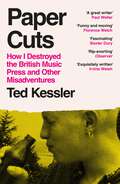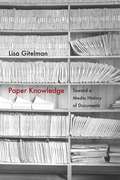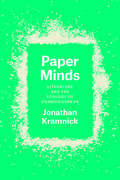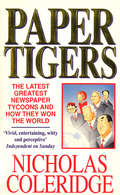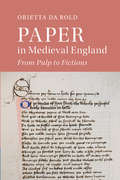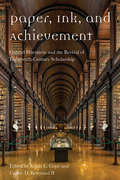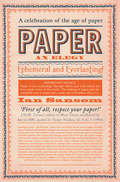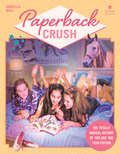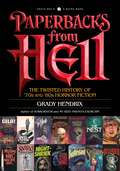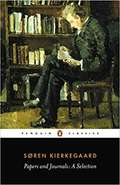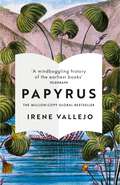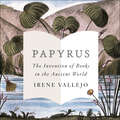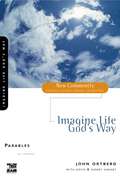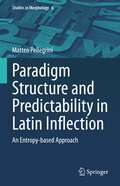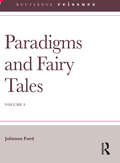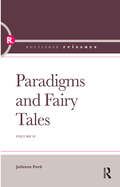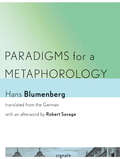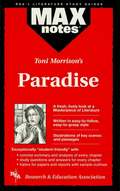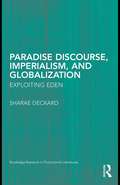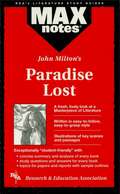- Table View
- List View
Paper Cuts: How I Destroyed the British Music Press and Other Misadventures
by Ted Kessler'A great writer' Paul Weller'A music journalist of integrity' Billy Childish'There's only one Ted Kessler!' Liam GallagherPAPER CUTS is the inside story of the slow death of the British music press. But it's also a love letter to it, the tale of how music magazines saved one man's life. Ted Kessler left home and school around his seventeenth birthday, determined 'to be someone who listened to music professionally'. That dream appeared forlorn when he was later arrested for theft behind the counter of the record shop he managed during acid house's long hot summer of love. Paper Cuts tells how Kessler found redemption through music and writing and takes us on a journey alongside the stars he interviewed and the work-place dramas he navigated as a senior staffer at NME through the boom-time '90s and on to the monthly Q in 2004, where he worked for sixteen years before it folded with him at its helm as editor in 2020.We travel in time alongside musical heroes Paul Weller, Kevin Rowland, Mark E Smith, and to Cuba twice, first with Shaun Ryder and Bez, then with Manic Street Preachers. We spend long, mad nights out with Oasis and The Strokes, quality time with Jeff Buckley and Florence Welch, and watch Radiohead deliver cold revenge upon Kessler in public. A story about love and death, about what it's like when a music writer shacks up with a conflict of interest, and what happens when your younger brother starts appearing on the cover of the magazines you work for, this is the memoir of "a delinquent doofus" whose life was both rescued and defined by music magazines.
Paper Cuts: How I Destroyed the British Music Press and Other Misadventures
by Ted Kessler'A great writer' Paul Weller'A music journalist of integrity' Billy Childish'There's only one Ted Kessler!' Liam GallagherPAPER CUTS is the inside story of the slow death of the British music press. But it's also a love letter to it, the tale of how music magazines saved one man's life. Ted Kessler left home and school around his seventeenth birthday, determined 'to be someone who listened to music professionally'. That dream appeared forlorn when he was later arrested for theft behind the counter of the record shop he managed during acid house's long hot summer of love. Paper Cuts tells how Kessler found redemption through music and writing and takes us on a journey alongside the stars he interviewed and the work-place dramas he navigated as a senior staffer at NME through the boom-time '90s and on to the monthly Q in 2004, where he worked for sixteen years before it folded with him at its helm as editor in 2020.We travel in time alongside musical heroes Paul Weller, Kevin Rowland, Mark E Smith, and to Cuba twice, first with Shaun Ryder and Bez, then with Manic Street Preachers. We spend long, mad nights out with Oasis and The Strokes, quality time with Jeff Buckley and Florence Welch, and watch Radiohead deliver cold revenge upon Kessler in public. A story about love and death, about what it's like when a music writer shacks up with a conflict of interest, and what happens when your younger brother starts appearing on the cover of the magazines you work for, this is the memoir of "a delinquent doofus" whose life was both rescued and defined by music magazines.
Paper Knowledge: Toward a Media History of Documents
by Lisa GitelmanPaper Knowledge is a remarkable book about the mundane: the library card, the promissory note, the movie ticket, the PDF (Portable Document Format). It is a media history of the document. Drawing examples from the 1870s, the 1930s, the 1960s, and today, Lisa Gitelman thinks across the media that the document form has come to inhabit over the last 150 years, including letterpress printing, typing and carbon paper, mimeograph, microfilm, offset printing, photocopying, and scanning. Whether examining late nineteenth century commercial, or "job" printing, or the Xerox machine and the role of reproduction in our understanding of the document, Gitelman reveals a keen eye for vernacular uses of technology. She tells nuanced, anecdote-filled stories of the waning of old technologies and the emergence of new. Along the way, she discusses documentary matters such as the relation between twentieth-century technological innovation and the management of paper, and the interdependence of computer programming and documentation. Paper Knowledge is destined to set a new agenda for media studies.
Paper Minds: Literature and the Ecology of Consciousness
by Jonathan KramnickHow do poems and novels create a sense of mind? What does literary criticism say in conversation with other disciplines that addresses problems of consciousness? In Paper Minds, Jonathan Kramnick takes up these vital questions, exploring the relations between mind and environment, the literary forms that uncover such associations, and the various fields of study that work to illuminate them. Opening with a discussion of how literary scholarship’s particular methods can both complement and remain in tension with corresponding methods particular to the sciences, Paper Minds then turns to a series of sharply defined case studies. Ranging from eighteenth-century poetry and haptic theories of vision, to fiction and contemporary problems of consciousness, to landscapes in which all matter is sentient, to cognitive science and the rise of the novel, Kramnick’s essays are united by a central thematic authority. This unified approach of these essays shows us what distinctive knowledge that literary texts and literary criticism can contribute to discussions of perceptual consciousness, created and natural environments, and skilled engagements with the world.
Paper Tigers
by Nicholas ColeridgePaper Tigers is a riveting, authoritative and in-depth study of newspaper barons of the world – men and women who wield immense power, and whose ever-changing media empires make compelling case studies of business success and failure.From Rupert Murdoch to Robert Maxwell, Conrad Black to Lord Rothermere, Katharine Graham to Punch Sulzberger, Coleridge interviewed them all. The results confirm his status as a devastatingly astute observer of our times, one with few equals today.
Paper in Medieval England: From Pulp to Fictions (Cambridge Studies in Medieval Literature #112)
by Orietta Da RoldOrietta Da Rold provides a detailed analysis of the coming of paper to medieval England, and its influence on the literary and non-literary culture of the period. Looking beyond book production, Da Rold maps out the uses of paper and explains the success of this technology in medieval culture, considering how people interacted with it and how it affected their lives. Offering a nuanced understanding of how affordance influenced societal choices, Paper in Medieval England draws on a multilingual array of sources to investigate how paper circulated, was written upon, and was deployed by people across medieval society, from kings to merchants, to bishops, to clerks and to poets, contributing to an understanding of how medieval paper changed communication and shaped modernity.
Paper of Wreckage: The Rogues, Renegades, Wiseguys, Wankers, and Relentless Reporters Who Redefined American Media
by Susan Mulcahy Frank DiGiacomoA jaw-dropping and unputdownable oral history of the New York Post and the legendary tabloid&’s cultural impact from the 1970s to today as recounted by the men and women who witnessed it firsthand. By the 1970s, the country&’s oldest continuously published newspaper had fallen on hard times, just like its nearly bankrupt hometown. When the New York Post was sold to a largely unknown Australian named Rupert Murdoch in 1976, staffers hoped it would be the start of a new golden age for the paper. Now, after the nearly fifty years Murdoch has owned the tabloid, American culture reflects what Murdoch first started in the 1970s: a celebrity-focused, noisy, one-sided media empire that reached its zenith with Fox News. Drawing on extensive interviews with key players and in-depth research, this eye-opening, wildly entertaining oral history shows us how we got to this point. It&’s a rollicking tale full of bad behavior, inflated egos, and a corporate culture that rewarded skirting the rules and breaking norms. But working there was never boring and now, you can discover the entire remarkable true story of America&’s favorite tabloid newspaper.
Paper, Ink, and Achievement: Gabriel Hornstein and the Revival of Eighteenth-Century Scholarship
by Philip Smallwood Susan Spencer James E May Manuel Schonhorn Leah Orr J. T. Scanlan Linda V. Troost Brett C. McInelly David VenturoDuring his forty-two years as president of AMS Press, Gabriel Hornstein quietly sponsored and stimulated the revival of “long” eighteenth-century studies. Whether by reanimating long-running research publications; by creating scholarly journals; or by converting daring ideas into lauded books, “Gabe” initiated a golden age of Enlightenment scholarship. This understated publishing magnate created a global audience for a research specialty that many scholars dismissed as antiquarianism. Paper, Ink, and Achievement finds in the career of this impresario a vantage point on the modern study of the Enlightenment. An introduction discusses Hornstein’s life and achievements, revealing the breadth of his influence on our understanding of the early days of modernity. Three sets of essays open perspectives on the business of long-eighteenth-century studies: on the role of publishers, printers, and bibliophiles in manufacturing cultural legacies; on authors whose standing has been made or eclipsed by the book culture; and on literary modes that have defined, delimited, or directed Enlightenment studies. Published by Bucknell University Press. Distributed worldwide by Rutgers University Press.
Paper, Materiality and the Archived Page (New Directions in Book History)
by Maryanne DeverThe emergence of digital technologies in the realm of archives has enlivened our understandings of archival materialities and lent a new intensity to our engagements with the archived page by prompting us to consider the potential of paper and the page in ways that we have hitherto largely ignored. Paper, Materiality and the Archived Page responds to this provocation by setting out an approach or an orientation to ‘thinking through paper’. Critically, it questions what work the archived page does if it is more than an invisible or transparent support to text. Three exemplary case studies are offered on the letters of Greta Garbo, the messy archival remains of Australian writer Eve Langley and the letters and manuscripts of English poet Valentine Ackland. Together they demonstrate how approaches grounded in concerns with materiality and matter can shift how we understand archival research and what we accept as archival ‘evidence’. They also reveal the emergent capacities of the paper page.
Paper: An Elegy
by Ian SansomLet us suppose for a moment that paper were to disappear. Would anything be lost? Everything would be lost. aper surrounds us. Not only as books, letters and diaries, but as beer mats and birth certificates, board games and business cards, fireworks and flypaper, photographs and playing cards, tickets and tea bags. We are paper people. But the age of paper is coming to an end. E-books regularly outsell physical books. E-tickets replace the paper variety. Archives are digitized. The world we know was made from paper, and yet everywhere we look, paper is beginning to disappear. As we enter a world beyond paper, Ian Sansom explores the paradoxes of the greatest of man-made materials and shows how some kinds of paper, and the ghosts and shadows of paper, will always be with us. Paper: An Elegy is a history of paper in all its forms and functions. Both a cultural study and a series of personal reflections on the meaning of paper, this book is a timely meditation on the very paper it is printed on.
Paperback Crush: The Totally Radical History of '80s and '90s Teen Fiction
by Gabrielle MossA hilarious and nostalgic trip through the history of paperback pre-teen series of the 80s and 90s.Every twenty- or thirty-something woman knows these books. The pink covers, the flimsy paper, the zillion volumes in the series that kept you reading for your entire adolescence. Spurred by the commercial success of Sweet Valley High and The Babysitters Club, these were not the serious-issue YA novels of the 1970s, nor were they the blockbuster books of the Harry Potter and Twilight ilk. They were cheap, short, and utterly beloved. PAPERBACK CRUSH dives in deep to this golden age with affection, history, and a little bit of snark. Readers will discover (and fondly remember) girl-centric series on everything from correspondence (Pen Pals and Dear Diary) to sports (The Pink Parrots, Cheerleaders, and The Gymnasts) to a newspaper at an all-girls Orthodox Jewish middle school (The B.Y. Times) to a literal teen angel (Teen Angels: Heaven Can Wait, where an enterprising guardian angel named Cisco has to earn her wings "by helping the world's sexist rock star.") Some were blatant ripoffs of the successful series (looking at you, Sleepover Friends and The Girls of Canby Hall), some were sick-lit tearjerkers à la Love Story (Abby, My Love) and some were just plain perplexing (Uncle Vampire??) But all of them represent that time gone by of girl-power and endless sessions of sustained silent reading.In six hilarious chapters (Friendship, Love, School, Family, Jobs, Terror, and Tragedy), Bustle Features Editor Gabrielle Moss takes the reader on a nostalgic tour of teen book covers of yore, digging deep into the history of the genre as well as the stories behind the best-known series.
Paperbacks from Hell: The Twisted History of '70s and '80s Horror Fiction
by Grady HendrixTake a tour through the horror paperback novels of the 1970s and ’80s . . . if you dare. Page through dozens and dozens of amazing book covers featuring well-dressed skeletons, evil dolls, and knife-wielding killer crabs! Read shocking plot summaries that invoke devil worship, satanic children, and haunted real estate! Horror author and vintage paperback book collector Grady Hendrix offers killer commentary and witty insight on these trashy thrillers that tried so hard to be the next Exorcist or Rosemary’s Baby. It’s an affectionate, nostalgic, and unflinchingly funny celebration of the horror fiction boom of two iconic decades, complete with story summaries and artist and author profiles. You’ll find familiar authors, like V. C. Andrews and R. L. Stine, and many more who’ve faded into obscurity. Plus recommendations for which of these forgotten treasures are well worth your reading time and which should stay buried.
Papers and Journals: A Selection
by Soren KierkegaardOne of the greatest thinkers of the nineteenth century, Søren Kierkegaard often expressed himself through pseudonyms and disguises. Taken from his personal writings, these private reflections reveal the development of his own thought and personality, from his time as a young student to the deep later internal conflict that formed the basis for his masterpiece of duality Either/Or and beyond. Expressing his beliefs with a freedom not seen in works he published during his lifetime, Kierkegaard here rejects for the first time his father's conventional Christianity and forges the revolutionary idea of the "leap of faith" required for true religious belief. A combination of theoretical argument, vivid natural description and sharply honed wit, the Papers and Journals reveal to the full the passionate integrity of his lifelong efforts "to find a truth which is truth for me." <p><p> For more than seventy years, Penguin has been the leading publisher of classic literature in the English-speaking world. With more than 1,700 titles, Penguin Classics represents a global bookshelf of the best works throughout history and across genres and disciplines. Readers trust the series to provide authoritative texts enhanced by introductions and notes by distinguished scholars and contemporary authors, as well as up-to-date translations by award-winning translators.
Papyrus: The No 1 International Bestseller
by Irene Vallejo'A literary phenomenon.' - Times Literary SupplementLong before books were mass produced, those made of reeds from along the Nile were worth fighting and dying for. Journeying along the battlefields of Alexander the Great, beneath the eruptions of Mount Vesuvius, at Cleopatra's palaces and the scene of Hypatia's murder, award-winning author Irene Vallejo chronicles the excitement of literary culture in the ancient world, and the heroic efforts that ensured this impressive tradition would continue.Weaved throughout are fascinating stories about the spies, scribes, illuminators, librarians, booksellers, authors, and statesmen whose rich and sometimes complicated engagement with the written word bears remarkable similarities to the world today: Aristophanes and the censorship of the humourists, Sappho and the empowerment of women's voices, Seneca and the problem of a post-truth world.Vallejo takes us to mountainous landscapes and the roaring sea, to the capitals where culture flourished and the furthest reaches where knowledge found refuge in chaotic times. In this sweeping tour of the history of books, the wonder of the ancient world comes alive and along the way we discover the singular power of the written word.
Papyrus: The No 1 International Bestseller
by Irene VallejoAn enthralling journey through the history of books and libraries in the ancient world and those who have helped preserve their rich literary traditions.Long before books were mass produced, those made of reeds from along the Nile were worth fighting and dying for. Journeying along the battlefields of Alexander the Great, beneath the eruptions of Mount Vesuvius, at Cleopatra's palaces and the scene of Hypatia's murder, award-winning author Irene Vallejo chronicles the excitement of literary culture in the ancient world, and the heroic efforts that ensured this impressive tradition would continue.Weaved throughout are fascinating stories about the spies, scribes, illuminators, librarians, booksellers, authors, and statesmen whose rich and sometimes complicated engagement with the written word bears remarkable similarities to the world today: Aristophanes and the censorship of the humourists, Sappho and the empowerment of women's voices, Seneca and the problem of a post-truth world.Vallejo takes us to mountainous landscapes and the roaring sea, to the capitals where culture flourished and the furthest reaches where knowledge found refuge in chaotic times. In this sweeping tour of the history of books, the wonder of the ancient world comes alive and along the way we discover the singular power of the written word.(P) 2022 Hodder & Stoughton Limited
Para qué escribir
by María Jimena DuzanUna recopilación de las mejores columnas de una de las mejores periodistas del país. Por más de una década la revista Semana ha publicado las columnas, entrevistas y crónicas de María Jimena Duzán. En estas ha quedado un registro de la realidad política del país, de los líderes y las fuerzas que compiten por el poder, así como de escandalosas formas de corrupción y graves atentados a la democracia; en sus investigaciones, Duzán elabora los grandes temas que ocupan el interés colectivo en un momento en que la sociedad ve pasar ante sí hechos que marcan el rumbo de su historia, como fueron desactivar una guerra y la vuelta de los gobiernos de derecha en el continente. En esta selección de sus mejores textos para la revista, María Jimena Duzán pone en perspectiva el oficio de periodista y su migración a las redes sociales. Su capacidad para escudriñar los fondos del poder junto a un gran talento para la investigación y el análisis de la coyuntura, la han convertido en una de las columnistas.
Parables of Coercion: Conversion and Knowledge at the End of Islamic Spain
by Seth KimmelIn the sixteenth and seventeenth centuries, competing scholarly communities sought to define a Spain that was, at least officially, entirely Christian, even if many suspected that newer converts from Islam and Judaism were Christian in name only. Unlike previous books on conversion in early modern Spain, however, Parables of Coercion focuses not on the experience of the converts themselves, but rather on how questions surrounding conversion drove religious reform and scholarly innovation. In its careful examination of how Spanish authors transformed the history of scholarship through debate about forced religious conversion, Parables of Coercion makes us rethink what we mean by tolerance and intolerance, and shows that debates about forced conversion and assimilation were also disputes over the methods and practices that demarcated one scholarly discipline from another.
Parables: Imagine Life God's Way (New Community Bible Study Series)
by John OrtbergSix-session small group studies to build true community within the church and among the worldParables: Jesus, the wisest man who ever lived, had much to say about God, the human heart, the future, life, anger, love, and everything that mattered. Digging into the treasure trove of the wisdom and truth hidden in his parables will stretch minds, feed souls, pierce hearts, and shape his followers into true disciples.
Paradigm Structure and Predictability in Latin Inflection: An Entropy-based Approach (Studies in Morphology #6)
by Matteo PellegriniLatin paradigms are almost proverbially known, and they have often been used as a test case for different theoretical approaches to morphological complexity. This book analyses them in a completely word-based perspective, using a recently developed information-theoretic methodology, making entropy-based techniques of analysis available to a wider readership. By doing so, it shows the relevance of traditional notions like principal parts, giving them a more principled, data-driven formulation. Furthermore, it suggests enhancements to the standard information-theoretic methodology, allowing to account for the role of external factors – like gender and derivational information – in improving predictability between inflected word forms. This book is useful to morphologists, that will see ideas and techniques taken from the current debate on morphological theory tested on complex phenomena of a language as renowned as Latin. It is also helpful for scholars working in both Latin and Romance linguistics: the former will find a freely available lexical resource and a novel description of Latin paradigms, that can be exploited by the latter to draw a comparison with recent analyses of the inflectional morphology of several Romance languages.
Paradigms and Fairy Tales: Volume 1
by Julienne FordThis book is an introduction to the epistemology and practice of social science. It provides an exposition and critique of the ideology and practice of social science, and an examination of the professional social scientist as a manipulator of ideas and appearances.
Paradigms and Fairy Tales: Volume 2
by Julienne FordThis book is an introduction to the epistemology and practice of social science. It provides an exposition and critique of the ideology and practice of social science, and an examination of the professional social scientist as a manipulator of ideas and appearances.
Paradigms for a Metaphorology
by Robert Savage Hans Blumenberg"Paradigms for a Metaphorology may be read as a kind of beginner's guide to Blumenberg, a programmatic introduction to his vast and multifaceted oeuvre. Its brevity makes it an ideal point of entry for readers daunted by the sheer bulk of Blumenberg's later writings, or distracted by their profusion of historical detail. Paradigms expresses many of Blumenberg's key ideas with a directness, concision, and clarity he would rarely match elsewhere. What is more, because it served as a beginner's guide for its author as well, allowing him to undertake an initial survey of problems that would preoccupy him for the remainder of his life, it has the additional advantage that it can offer us a glimpse into what might be called the ‛genesis of the Blumenbergian world.’"-from the Afterword by Robert SavageWhat role do metaphors play in philosophical language? Are they impediments to clear thinking and clear expression, rhetorical flourishes that may well help to make philosophy more accessible to a lay audience, but that ought ideally to be eradicated in the interests of terminological exactness? Or can the images used by philosophers tell us more about the hopes and cares, attitudes and indifferences that regulate an epoch than their carefully elaborated systems of thought?In Paradigms for a Metaphorology, originally published in 1960 and here made available for the first time in English translation, Hans Blumenberg (1920-1996) approaches these questions by examining the relationship between metaphors and concepts. Blumenberg argues for the existence of "absolute metaphors" that cannot be translated back into conceptual language. These metaphors answer the supposedly naïve, theoretically unanswerable questions whose relevance lies quite simply in the fact that they cannot be brushed aside, since we do not pose them ourselves but find them already posed in the ground of our existence. They leap into a void that concepts are unable to fill.An afterword by the translator, Robert Savage, positions the book in the intellectual context of its time and explains its continuing importance for work in the history of ideas.
Paradise (MAXNotes Literature Guides)
by David GracerREA's MAXnotes for Toni Morrison's Paradise MAXnotes offer a fresh look at masterpieces of literature, presented in a lively and interesting fashion. Written by literary experts who currently teach the subject, MAXnotes will enhance your understanding and enjoyment of the work. MAXnotes are designed to stimulate independent thought about the literary work by raising various issues and thought-provoking ideas and questions. MAXnotes cover the essentials of what one should know about each work, including an overall summary, character lists, an explanation and discussion of the plot, the work's historical context, illustrations to convey the mood of the work, and a biography of the author. Each chapter is individually summarized and analyzed, and has study questions and answers.
Paradise Discourse, Imperialism, and Globalization: Exploiting Eden (Routledge Research in Postcolonial Literatures)
by Sharae DeckardThis comparative study, the first of its kind, discusses paradise discourse in a wide range of writing from Mexico, Zanzibar, and Sri Lanka, including novels by authors such as Malcolm Lowry, Leonard Woolf, Juan Rulfo, Wilson Harris, Abdulrazak Gurnah, and Romesh Gunesekera. Tracing dialectical tropes of paradise across the "long modernity" of the capitalist world-system, Deckard reads literature from postcolonial nations in context with colonial discourse in order to demonstrate how paradise begins as a topos motivating European exploration and colonization, shifts into an ideological myth justifying imperial exploitation, and finally becomes a literary motif used by contemporary writers to critique neocolonial representations and conditions in the age of globalization. Combining a range of critical perspectives—cultural materialist, ecocritical, and postcolonial—the volume opens up a deeper understanding of the relation between paradise discourse and the destructive dynamics of plantation, tourism, and global capital. Deckard uncovers literature from East Africa and South Asia which has been previously overlooked in mainstream postcolonial criticism, and gestures to how the utopian dimensions of the paradise myth might be reclaimed to promote cultural resistance.
Paradise Lost (MAXNotes Literature Guides)
by Corinna RuthREA's MAXnotes for John Milton's Paradise Lost MAXnotes offer a fresh look at masterpieces of literature, presented in a lively and interesting fashion. Written by literary experts who currently teach the subject, MAXnotes will enhance your understanding and enjoyment of the work. MAXnotes are designed to stimulate independent thought about the literary work by raising various issues and thought-provoking ideas and questions. MAXnotes cover the essentials of what one should know about each work, including an overall summary, character lists, an explanation and discussion of the plot, the work's historical context, illustrations to convey the mood of the work, and a biography of the author. Each chapter is individually summarized and analyzed, and has study questions and answers.
